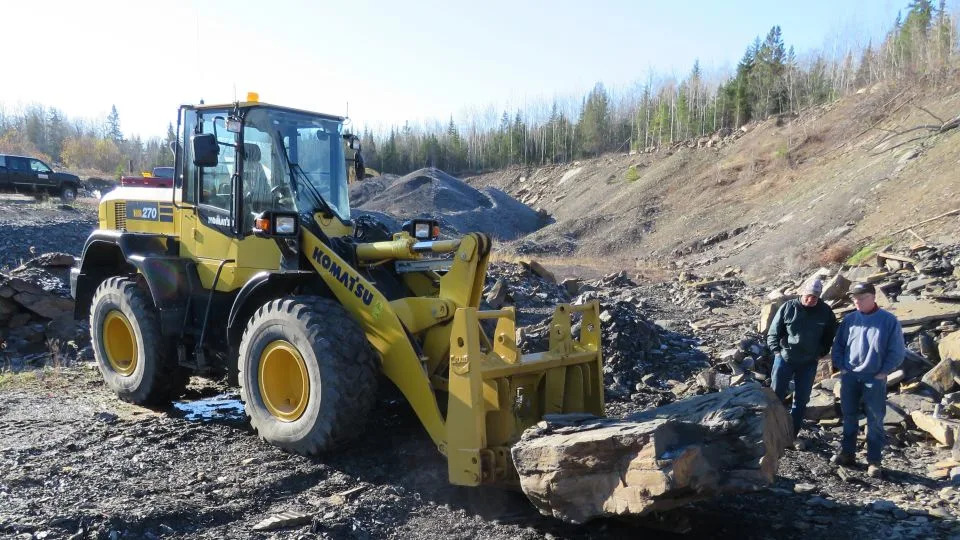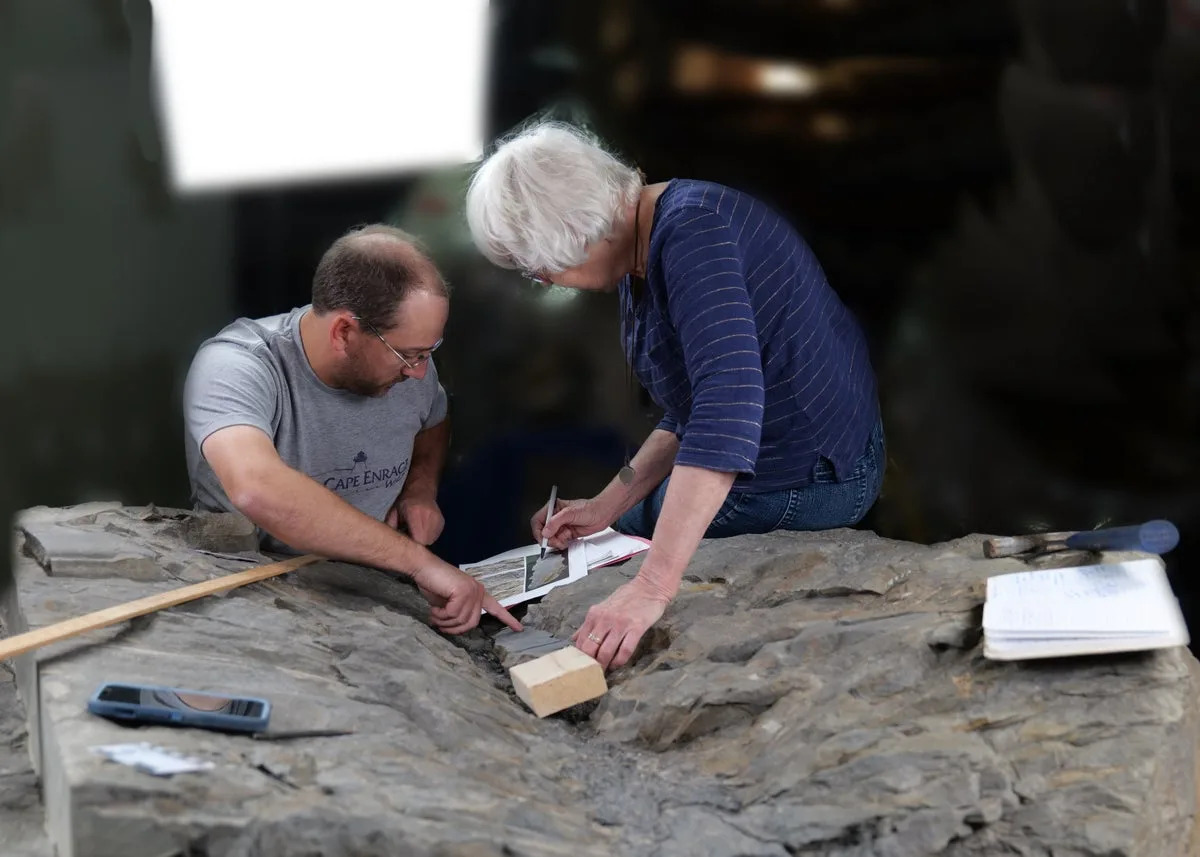Julian Spector
Thu, February 1, 2024

The scraggly grasses and standing water at the Spindletop oil field, near Beaumont in east Texas, don’t immediately suggest the site of a world-changing energy breakthrough. But there, one morning in 1901, workers released a gusher of oil over 100 feet high, turning Texas into a global capital of fossil-fuel extraction.
That coastal landscape soon drew a frenzied boomtown of oil rigs, and they sucked out the ancient fuel that had pooled around the subterranean salt dome. Eventually, the oil dried up, and the industry left for opportunities elsewhere. Now, 4,000 feet below Spindletop, the same geologic salt formation houses the molecule spurring the latest Gulf Coast energy boom: hydrogen.
Unlike with oil, people put the hydrogen there. Spindletop’s salt dome is just one node in a network of hydrogen production, pipelines and underground storage that stretches across Texas and the Gulf region — a kind of sub-industry serving the better-known petrochemical sector. In response to more stringent air-quality regulations in the 1990s, refiners needed more hydrogen to desulfurize their fuels. They also needed it to “crack” heavy hydrocarbons.
Cleaning up tailpipe exhaust created problems for the climate: Traditional hydrogen production essentially cooks methane with steam and vents the resulting carbon dioxide into the atmosphere. It has become one of the largest industrial greenhouse gas emitters in a region infamous for industrial emissions.
But these days, everyone from ExxonMobil to pure-play renewable developers is vying to turn Houston into a global center for low-carbon hydrogen. Methane-based hydrogen producers are looking to add carbon-capture devices and sequester emissions underground. Others plan to funnel solar and wind power directly into electrolyzers, producing hydrogen without any fossil fuels.
Cleaning up hydrogen could position the Gulf at the center of efforts to decarbonize a range of dirty industries — think shipping, long-distance trucking and carbon-intensive industrial processes. The Biden administration has enacted an unprecedented tax credit to lower the premium for “clean” hydrogen and invested $7 billion across seven regional hubs to jump-start production, distribution and use of the clean molecule. Houston’s HyVelocity Hub won a chunk of that change last fall, and it is negotiating final terms with the Department of Energy.
Thus far, though, clean-hydrogen production scarcely exists, and it remains far from achieving industrial scale. Climate advocates hotly contest what should even qualify as “clean” hydrogen and how exactly this resource should be used to best serve the economywide transition from fossil fuels.
Nevertheless, if I had to bet on where clean hydrogen takes off first, my money’s on the Gulf Coast.
“There’s been a hydrogen economy here for a very long time, whereas some of the other hubs are essentially building it from scratch,” said Alan Alexander, a Houston-based partner at law firm Vinson & Elkins specializing in hydrogen deals.
Over two weeks traversing the region this winter, I saw others were putting their money on Houston, too.
“There's a lot of interest and a lot of developers chasing projects,” said Brett Perlman, CEO of the Center for Houston’s Future. The nonprofit, which helped coordinate Houston’s winning hub proposal, had tallied 35 hydrogen production projects in the region as of six months ago. “Maybe some of them are doing it to address climate change,” but they also want to make a return on their investment, Perlman noted.
Perlman witnessed the dawn of the competitive ERCOT electricity markets as a Texas utility regulator, and he recognizes something in the air now that’s reminiscent of those days. Two decades after opening up the grid to entrepreneurial development, Texas has built more renewables than any other state.
That urge for profit could do for hydrogen what it did for renewables, but hydrogen’s climate calculus is not so clear-cut as, say, pushing coal out of the power market. If Exxon and Chevron want to turn fossil fuels into a “clean” product, much of which goes to refining other fossil fuels, is that really advancing the transition to clean energy?
It’s already clear, though, that the Gulf hydrogen boom will merge the fossil fuel and clean energy industries in fundamentally new ways. The clean hydrogen economy needs skilled workers to install pipelines, drill storage caverns and handle pressurized gases. A just transition requires a realistic pathway for energy workers to shift to decarbonization; hydrogen could deliver on that promise.
Critics call hydrogen a distraction, a boondoggle, a rearguard action by fossil-fuel interests. But developers I spoke to who actually build wind and solar are coming to view hydrogen as a force to unleash untold quantities of renewable generation in the near future. And they’re confident that the falling arc of renewable and electrolyzer costs ultimately will make their clean hydrogen cheaper than a product that requires tinkering with capture equipment and sequestering carbon in perpetuity.
If they are right, the Gulf Coast will be reshaped by a new fuel, one that reduces carbon emissions rather than increasing them.
The Gulf is already a hydrogen hub — it just isn’t clean yet
To understand how hydrogen could be produced cleanly at scale, I needed to see how it’s made currently.
I drove east along Houston’s industrial shipping channel, past tanks and tubes and towers, refineries that stretch like cities unto themselves. Billowing smokestacks augmented the low gray clouds pelting rain on the freeway.
I plowed through the spray from 18-wheelers and exited the highway into coastal flatlands, scanning for the logo of a 120-year-old French company that’s become a central player in the U.S. hydrogen market. After passing through a series of gates, I alighted at Air Liquide’s La Porte steam methane reforming facility, one of the company’s largest in the world when completed in 2011.
Rich Fenza, the company’s director of operations for Gulf Coast hydrogen production and pipeline network, met me in the control center. On the wall of the snack room, I spotted a framed photograph of Energy Secretary Jennifer Granholm, who visited on her first official trip out of Washington, D.C. Fenza showed me around, pointing out where methane flows in from the natural-gas network and gets scrubbed of any residual sulfur before it rushes into the reformer.
That multistory insulated metal box holds 400 catalyst tubes at a temperature of 2,000 degrees Fahrenheit. Methane and steam flush through pipes until the heat and pressure split them into hydrogen gas, carbon dioxide and carbon monoxide. The carbon dioxide flies away; the hydrogen goes through a pressure swing absorber that purifies it, before a compressor squeezes it into a bright red pipeline and on to the petrochemical kingdoms of Texas City, Port Arthur, Freeport.
The whole agglomeration of tanks, tubes and reformer, collectively called a train, fits in a space not much bigger than a football field.
Air Liquide oversees a formidable Gulf Coast empire. The company makes 116.5 million standard cubic feet of hydrogen per day at La Porte; three other reformers bring regional total production to 400 million “scuffs” each day. It operates 330 miles of hydrogen pipeline to deliver the goods, and it taps its underground salt cavern at Spindletop when it needs to conduct maintenance at production plants or has to meet surges in demand. The cavern, which came online as a hydrogen storage facility in 2016, holds 4.5 billion cubic feet at pressures up to 3,000 pounds per square inch, so when Air Liquide opens a valve, the gas is ready to go.
A handful of other legacy suppliers produce and distribute at this level: Air Products, Linde. Some large refineries make their own hydrogen on-site, pumping it directly into refining operations. All of them vent carbon dioxide into the atmosphere.
Industrial emissions constitute roughly one-third of the greater Houston area’s greenhouse gas pollution, Perlman said; hydrogen produced via methane reforming singlehandedly generates about 25% of those industrial emissions. To reduce carbon emissions, Houston must clean up hydrogen production, and that will require doing something new with that colorless, odorless gas flying out of methane reformers.
“Hydrogen has been around for quite some time, so the first step is to take that hydrogen and decarbonize it,” said Matthieu Giard, the French executive who runs Air Liquide’s entire Americas operation from the top floor of a skyscraper west of downtown Houston.
Over at Air Liquide’s La Porte site, Fenza added that “there's too much invested in all these plants to just say, ‘They're obsolete, let's shut them all down.’” Fenza’s team won a grant from the DOE to conduct the engineering studies necessary to retrofit La Porte with carbon-capture equipment. The relatively new La Porte site has ample space to host this additional machinery. And Air Liquide has already developed tools that can scrub carbon from a smokestack; it uses similar techniques to isolate other industrial gas products.
Carbon capture has been tried many times on power plants, and it typically proves expensive and ineffective. Running capture equipment is energy-intensive, and projects meant to prove the efficacy of the technology have routinely failed to capture as much carbon dioxide from power plant fumes as they were supposed to.
Air Liquide, though, has operated its “Cryocap H2” technology on a steam methane reformer in Port-Jérôme, France since 2015. Reformers release carbon in a much more concentrated stream than power-plant smokestacks, Giard said, enabling higher-caliber performance (the process requires electricity, which could yield carbon emissions depending on the source). The company says its French facility is able to capture 95% or more of its carbon dioxide output, which Air Liquide then sells. An alternative technique for hydrogen production called autothermal reforming, or ATR, works even better with carbon capture.
“It still starts with a hydrocarbon feedstock, but it keeps all the reaction products, including the carbon, at high pressure,” said Fenza. “By keeping it at high pressure, [the carbon] is a lot easier to remove.”
Giard described ATR technology as “something that we can do tomorrow,” but acknowledged the company doesn’t yet operate a full-scale ATR plant. Air Liquide is building one in Japan.
Giard described ATR technology as “something that we can do tomorrow,” but acknowledged the company doesn’t yet operate a full-scale ATR plant. Air Liquide is building one in Japan.
So while hydrogen with carbon capture hasn’t scaled up yet, Perlman told me “it's an integration issue, not a technology issue.” The industry doesn’t need to invent anything new or wait for dramatic cost reductions.
But the carbon still has to go somewhere. Here too, the energy industry has experience. The Gulf already hosts some carbon dioxide pipelines, and the technical details of transporting carbon from a steam methane reformer to storage are well understood. Long-term sequestration similarly relies on existing techniques.
“It’s basically production in reverse,” said Kenneth Medlock, senior director of the Center for Energy Studies at Rice University. “That’s nothing new; oil and gas producers have been doing that for a long time.”
Over the last 50 years, American operators have injected more than 1 billion tons of carbon dioxide underground, said Ben Grove, a geoscientist who tracks carbon sequestration for climate think tank Clean Air Task Force. Most of that went into oil fields to flush out more fossil fuel, a technique known as enhanced oil recovery, but the CO2 has stayed down there.
Oil and gas companies are now focusing on sequestering carbon in areas that don’t have fossil fuel deposits, which earns them a higher tax credit from the Inflation Reduction Act. This entails drilling through nonporous cap rock and pumping carbon down to a porous geological layer, like sandstone, where it squeezes into minuscule gaps in the rock.
It turns out, “the best storage potential in the country is in the Gulf Coast region — it’s some of the best in the world,” Grove said.
Lastly, any industry that depends on methane as a feedstock must confront upstream emissions of the potent greenhouse gas. Independent research has found that methane leakage from wellhead to customer is much higher than previously thought, and unburned methane warms the planet 28 times more than carbon dioxide over a 100-year period.
To become truly low-carbon, Houston’s fossil-fueled hydrogen ecosystem would need to eliminate upstream methane emissions, capture almost all emissions from hydrogen production, pump this industrial-scale volume of CO2 underground, and keep it there, forever. The hydrogen industry has never performed all these steps in sequence.
The Gulf isn’t just looking at decarbonizing existing SMRs; economic-development types and energy tycoons alike want to build a bunch of brand-new methane-based hydrogen facilities. After all, if hydrogen becomes the fuel of choice for decarbonizing crucial industrial activities, that will require far more volume than what’s coming out of methane reformers today. This proposed buildout — supported by the DOE hub grant — would lock in additional gas consumption for decades to come, based on the expectation that emissions will be captured and permanently stored.
All of this raises the stakes enormously on whether carbon capture works in practice. But that’s not the only path forward for the Gulf’s hydrogen boom. A different cohort of climate-oriented entrepreneurs aims to prove they can make clean hydrogen, cheaply, at scale, while ditching fossil fuels entirely.
Renewable megaprojects incoming
The pines rise from sandy Mississippi soil, mastlike against the horizon. But where I stand, the timber crop is long gone, leaving a white crust exposed between fluffy-seeded grasses.
“Is that the salt?” I ask my hosts, the executive team of Hy Stor. The company plans to use the former logging tract to store vast amounts of renewably powered hydrogen. It turns out I’m a little off. Jill Kinnard, Hy Stor’s senior vice president of land, pipelines and contract management, tells me that the rock-solid salt formation known as the Richton Dome starts roughly 400 feet below us and stretches down thousands of feet beyond that. That’s where the renewably generated hydrogen will go.
Some of the most ambitious ideas for clean hydrogen in the Gulf come not from fossil fuel developers but from dyed-in-the-wool green progenitors, using only renewable electricity to create vast amounts of hydrogen. The bigness is a strategic necessity for this form of production, commonly described as “green” hydrogen, said Nabil Bennouna, a principal for clean hydrogen at think tank RMI. (Canary Media is an independent affiliate of RMI.)
“In order to get green hydrogen to a price that is competitive against alternatives, you need scale,” Bennouna said. “If you are interested in having a long-term viable business model, those are the ambitions you need to have.”
Before I left Houston, I met a team of developers from Apex Clean Energy at a restaurant a few parking lots over from Air Liquide’s skyscraper. For Apex, “Hydrogen is a way to bring more wind and solar online,” said Laura Merten, a policy manager tracking hydrogen for the company.
The plan is to build what could be the nation’s biggest renewable power plant, many gigawatts strong, deep in West Texas. There’s no way for that power to reach customers on the Gulf Coast — the grid simply can’t carry that much without woefully expensive upgrades. Apex proposes turning that ideal West Texas wind and sunshine into hydrogen on the spot, then shooting it through a brand-new pipeline, roughly paralleling the Rio Grande, hundreds of miles to the coast.
Apex, a veteran wind, solar and battery storage development firm based in Charlottesville, Virginia, has never built a pipeline. But, conveniently, its corporate cousin Epic Midstream has experience running fossil gas pipelines in the region. The Apex Rio project nonetheless represents a tremendous undertaking, which the company hopes to bring online in the latter half of this decade.
Over in southern Mississippi, Hy Stor’s vision operates on a similarly grand scale. The company, with just a dozen full-time employees, has acquired rights to nearly 70,000 acres across several counties in a state with almost no renewable power installed today. In just the first phase, Hy Stor will add around 2.7 gigawatts of electrolyzers, powered by twice that capacity of onshore wind, solar and geothermal. This off-grid design ensures that the hydrogen will be clean, a commitment that attracts customers who are serious about decarbonization, CEO Laura Luce told me.
But wind and solar produce, famously, not all the time. To neutralize the downsides of this very cheap but intermittent power source, Luce and Co. will pipe their super-clean hydrogen into underground caverns ahead of customer deliveries, then top up the caverns on an ongoing basis as the renewables are used to generate more.
Hy Stor is also developing industrial parks for customers who want to turn super-clean hydrogen into things like sustainable fertilizer, green steel, chemicals or maritime fuel. One of these sits 10 miles down the road from the Richton Dome site, on 1,100 acres connected to highway and rail.
How does one go about creating massive and cost-effective underground hydrogen storage? Hy Stor first acquired land rights, subsurface rights, water rights and the necessary permits to burrow into that immense, subterranean bulb of salt far below my feet. The plan is to pump down (nonpotable) water from the nearby Leaf River to dissolve the salt and suck out the ensuing brine through a supersized straw. Layer by layer, over about two years, this procedure will excavate a hollow cylinder, hundreds of feet tall but located thousands of feet underground. From where I stood soaking in the slantwise afternoon sun of early December, all I’d be able to see is a fenced-off clearing with some piping protruding from the ground.
And that’s just one cavern in one salt dome. Hy Stor has the rights to 10 different salt domes, eight in Mississippi, two in Louisiana. Each dome is large enough to house multiple caverns drilled at safe distances from each other, Luce said, at least 1,000 feet from wellhead to wellhead. Someday not long from now, Hy Stor could be operating hundreds of clean-hydrogen storage caverns, provided the company enlists enough industrial demand to justify that scale of drilling.
If that all sounds hard to fathom, Luce points out that she’s drilled storage caverns for natural gas in her career prior to Hy Stor. Some of those caverns occupy portions of the same salt domes Hy Stor is targeting now.
“We’re creating something that doesn’t exist, but all the ingredients are there,” Luce said. “In Mississippi, you’ve got all the things that are hard to build from scratch.”
Like the salt domes. Back at Hy Stor’s office on the Mississippi coast, Luce opened a geological textbook called, fittingly, Salt Domes, and unfurled a map of all the known formations in the Gulf Coast. Scores of them dot the coastal belt, keepsakes of a more tectonically turbulent prehistory. Many have been thoroughly documented because of their tendency to house oil and gas deposits.
Making underground caverns to store clean hydrogen fundamentally differs from, say, developing novel long-duration grid batteries to hold clean electricity for days or months. Hy Stor doesn’t need to invent anything or prove some novel combination of technologies. It just has to combine technologies that have already been well proven.
There are risks, such as uncertainties around securing the rights to run pipelines to connect electrolyzers with caverns and customers. Having reported on the occasional local opposition to inert solar power plants, I assumed that getting permission to carve up the land to run pipes of combustible gas through it might be challenging.
But in Mississippi, pipelines already crisscross the working landscape. I originally met the Hy Stor team at Fulmer’s Farmstead, a bucolic pecan orchard with a general store and meat-and-three lunch service. Kinnard developed dozens of natural gas and carbon dioxide pipelines over a two-decade career before landing at Hy Stor. While filling me in on the finer points of rights of way and surface titles, she mentioned she’d run one pipeline through this very property — over there, between the pecan trees.
Once you get the necessary permissions, it’s just a matter of digging a trench, covering the pipe with enough dirt to safely drive over, and making sure the landowner doesn’t build on top of it, Kinnard said. She handed me a representative cross-section of the likely hydrogen pipe: PVC, 8-inch diameter, about the same width as a basketball.
At one point, as we drove out of the Richton Dome parcel, a Hy Stor member in the car fielded a call from someone responding to a pipeline survey request. The company needs permission to send teams onto people’s property to visually assess where to run the pipe. Pretty soon, the caller was inquiring whether Hy Stor was hiring.
The energy industry employs a sizable portion of the workforce in Mississippi, but the state itself no longer produces much oil and gas. That means Mississippians spend their shifts on offshore rigs in the Gulf, or over in the Permian in Texas — far from family and home. Hy Stor pitches a chance to stay put and earn a living with the same skills: drilling, pipeline construction, pressurized gas management.
“We can make our own energy in our own backyard — that's pretty inspiring,” Luce said. Hy Stor plans to hire thousands of workers for construction and hundreds for ongoing operations, paid above the prevailing wage.
In Louisiana, the still-dominant oil and gas industry has nonetheless shed thousands of jobs in the last two decades, said Lacy McManus, executive director of future energy at Greater New Orleans, the regional economic development agency. She and other Gulf Coast economic boosters talk about hydrogen production, and related carbon pipelines and sequestration projects, as growth sectors within the energy industry that could boost regional employment. Perlman with the Center for Houston’s Future said that hydrogen “could certainly be a big driver of economic growth” for the region in the coming decade.
But to actually change regional employment prospects, developers like Hy Stor need one more piece of the puzzle to fall into place: firm customer commitments. Before Hy Stor starts drilling its caverns, it has to have prospective buyers lined up who are willing to design and engineer new factories that can receive clean hydrogen from the future caverns. It’s like choreographing an intricate tango while dancing it.
Hy Stor has been chasing this vision for several years, with investment from Canadian pension fund Connor, Clark & Lunn. Now, several customers are expected to finalize their factory investments in the first half of 2024, which would give Hy Stor enough certainty to break ground and start delivering carbon-free hydrogen by late 2026 or early 2027. The company can drill more caverns as additional industrial users lock in orders.
If contracts fall into place and construction stays on schedule, the long-promised little molecule will flow beneath the Mississippi dirt in just three years.
The long game: Which clean hydrogen will win?
Dozens of companies are racing to produce low-carbon hydrogen. What isn’t clear is who will win out, and whether this competitive mélange will ultimately lower planet-warming emissions. To properly evaluate carbon impacts, though, analysts need empirical data on operating projects.
“There are lots of uncertainties associated with new technologies — we need better data on what the negative path dependencies are for certain production pathways,” said RMI’s Bennouna.
The methane-based hydrogen camp has a head start, commercially: Steam methane reformers already operate in the region; companies just need to figure out how to profitably combine them with carbon capture and sequestration. In contrast, renewable electrolysis has only happened at small scale: Air Liquide set a world record when it installed 20 megawatts of electrolyzers in Quebec in 2021. A company called H2B2 claimed the largest renewable electrolysis site in the U.S. when it opened a facility with 3 megawatts of capacity in Fresno late last year, using biogas from a nearby dairy farm. These early projects make liquefied hydrogen for vehicles, in part because they aren’t big enough to serve the industrial customers that get hydrogen delivered via pipeline.
Renewable hydrogen developers worry about getting their hands on enough electrolyzers, since the supply chain has never executed at the scale that Gulf Coast entrepreneurs need. They also have to contend with the well-documented obstacles to adding huge amounts of renewables to the grid — hence Hy Stor’s and Apex’s predilection for building off-grid power plants.
Air Liquide takes an ecumenical perspective on hydrogen technologies: Its corporate mission is to sell oxygen, nitrogen and hydrogen, not hydrocarbons. The company’s portfolio of inventions includes steam methane reformers, autothermal reformers and carbon capture, but it recently opened a factory in Berlin with Germany’s Siemens Energy to mass-produce electrolyzers; it can make 1 gigawatt worth of them per year now, growing to 3 gigawatts by 2025.
“Today, if you want to decarbonize very fast, the best way is probably to do some SMR and ATR with carbon capture, because the technology is there, at scale,” Air Liquide’s Giard said. “It's competitive, and the carbon-capture piece is existing in Texas, so that's fantastic. But let's not discount electrolysis, because we have a lot of [renewable] energy in Texas.”
Electrolysis fans believe plummeting costs for renewables and electrolyzers give them a long-term edge. Both technologies rely on modular, mass-produced building blocks that have been proven to decline in cost predictably over time (see the runaway success of renewables in Texas). SMRs and carbon capture, on the other hand, require large upfront capital investment, and that’s not about to change. If the more bullish visions for renewables come true, clean electrolytic hydrogen will simply become cheaper, putting a damper on the business prospects for new carbon-capture hydrogen.
Developers in both camps also need to figure out what kind of infrastructure the Gulf should build to deliver this new product. Regional boosters like to talk up the benefits of the existing pipeline network, but the truth is, those pipelines aren’t open to newcomer hydrogen producers.
“We have private-carrier pipelines for ourselves, and so do our colleagues in the industry,” Air Liquide’s Fenza explained. “We feel like that's the best model to really deliver most cost-effectively for the customers and for ourselves.”
The pipes run from each producer to the customers who signed bilateral contracts with them. It calls to mind the earliest days of the electric grid, when each power company ran its own wires to customers, shading the streets of New York City with an overlapping mess of redundant wires.
Granted, the hydrogen network won’t need to reach as many destinations as the electrical grid. Air Liquide’s Giard assured me the private-carrier model works just fine.
“For us, it's very important to master our universe, A to Z, and make sure that we can provide that very high reliability that [customers] want,” he said. “So having a private network is definitely important for us.”
The hardcore renewables developers tend to prefer the alternative. “We are evaluating overbuilding the capacity of the pipeline to support others injecting,” Merten said of Apex’s West Texas project. “The goal is to support and help develop this whole hydrogen economy.”
Hy Stor plans to eventually open its pipeline network to others, provided they can guarantee carbon-free hydrogen; the company doesn’t want to jeopardize the high standard it’s pitching to customers.
Perlman believes open-access pipelines could expand the overall market for clean hydrogen. He wants to replicate what Louisiana’s Henry Hub did for natural gas: connecting so many different pipelines produced the most dynamic market for gas trading in the country, maybe the world, Perlman explained.
“We want to create this market that basically expands, and to do that, we'll have to have the same sort of interconnected infrastructure,” Perlman said. “You want not just physical transactions — you want financial transactions, and you want transparency.”
The hitch is, nobody’s developed a framework for regulating hydrogen pipelines, beyond the basic pipeline-safety duties overseen by the U.S. Department of Transportation. The Texas legislature passed a law last year to grant clear hydrogen-pipeline jurisdiction to the Texas Railroad Commission.
“Because everything's bigger in Texas, we have enough pipeline capacity to have our own sort of regulatory jurisdiction, and that's what we're trying to do,” Perlman said.
The to-do list for hydrogen developers remains daunting: build a facility at a scale the world has never seen and convince large industrial customers to pay an initial green premium for the same commodity; invent new rules of the road for a shared pipeline network that doesn’t exist yet; and outcompete other developers attempting their own version of this novel low-carbon commodity.
But the clean energy transition is rife with unresolved challenges: overhauling America’s sclerotic process for permitting transmission lines, figuring out how to store renewable power far longer than any battery has before, unlocking the secret of nuclear fusion to power humanity. Compared to those tasks, inventing a clean hydrogen economy in the Gulf doesn’t look so gnarly. Many of the steps, like making the perfect storage vessel thousands of feet below the earth, have been done before, repeatedly. The region knows how to vigorously exploit a hydrocarbon energy boom; it just needs to unleash the hydro, but hold the carbon.
Verdagy manufactures an advanced AWE electrolyzer system that has superior performance to almost any system in the market — high current densities and the largest membranes leading to higher hydrogen production, high efficiencies leading to lower LCOH, and wide dynamic range and fast turndowns to seamlessly integrate with renewables. In addition to its Silicon Valley factory, Verdagy operates its R&D and highly automated commercial pilot plants in Moss Landing, California, where it continues to advance its cutting-edge technology.















